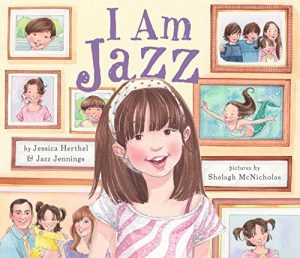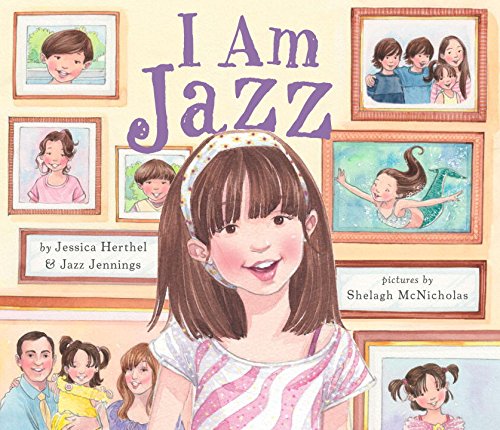I take my children to the library every Monday.
We return our stack of books from the previous week, and then my daughter—age four—runs around grabbing new tomes for me to soothe her to sleep with. Being four, she chooses according to what’s on the cover. When we head to check out, I carry a stack of princesses, baby animals, and other such items of note that tend to appeal to young girls.
(My son, for the record, heads straight to the computers. He is two-years-old, has his favorite reads at home, and is particular when it comes to adding new titles.)
Last Monday, my daughter threw a book titled I Am Jazz into the pile.
 Like every other item, I saw a little girl pretending to be a mermaid on the cover. “That’s why she grabbed this” crossed my mind, but beyond that I didn’t give it another thought. I didn’t examine the back, read the jacket, or delve any deeper into what I was getting myself into.
Like every other item, I saw a little girl pretending to be a mermaid on the cover. “That’s why she grabbed this” crossed my mind, but beyond that I didn’t give it another thought. I didn’t examine the back, read the jacket, or delve any deeper into what I was getting myself into.
That night, as always, my wee one chose three books to read before bed. I Am Jazz was first on the list.
“This is number one, Daddy,” she told me with her serious face.
It is very important I read her books in the correct order. If I were to read book number two before book number one? Well, that would cause crying, and mass hysteria. Dogs and cats living together. That sort of thing. Mostly crying.
I found I Am Jazz somewhat bland at first. The first few pages were filled with little simplicities—“I like princess gowns, I like cartwheels…”—and so on and so forth.
Then I turned a page.
I read the words aloud before fully realizing what they said. And then I paused. And then a wide smile spread across my face and I started laughing. What I discovered was a bigger twist than M. Night Shyamalan has ever created, and it was absolutely more brilliant than his nonsense.
“I have a girl brain but a boy body. This is called transgender.”
After I recovered from my giggle-fit of surprise, I continued reading. From that page forward was a delightfully modest and straightforward explanation of what it means to be transgender. The child in question, Jazz herself, was treated with dignity, respect, and above all else, normalcy.
“I have a girl brain but a boy body.”
That’s it in a nutshell.
Some people are born different, and different is OK.
The book touched on bullying and visiting a doctor for the official diagnosis, but as a children’s book it didn’t to go too far into these subjects. It’s not supposed to; it is a perfect introduction to a marginalized populace finally being normalized by society.
(If only in the tiniest of baby steps.)
My daughter enjoyed the tale, and even though she doesn’t realize it yet, she’s learning an important lesson about life. The book is a wonderful overview of what transgender means; a wonderful presentation of “different from me, but the same as me.”
The next night, I read I Am Jazz to both my daughter and son.
He didn’t appreciate it as much as he does Thomas & Friends, but he’ll get it someday. Best to start early, because it’s so much better to instill love than bigotry.
I’m writing this note on a Saturday afternoon, meaning it’s been several days since our trip to the library. In the interim, I’ve read the book nightly, and come across my daughter leafing through it randomly throughout the week. She’ll be in her chair or on her bed, whispering to herself happily: “I like cartwheels.”
OK, so cartwheels might not be the point of the book, but what’s important is that the seed of tolerance and acceptance has been planted. When my daughter heard “I have a girl brain but a boy body,” she didn’t flinch. That’s what’s important.
Themes of positivity and self-worth will always be welcome under my roof.
